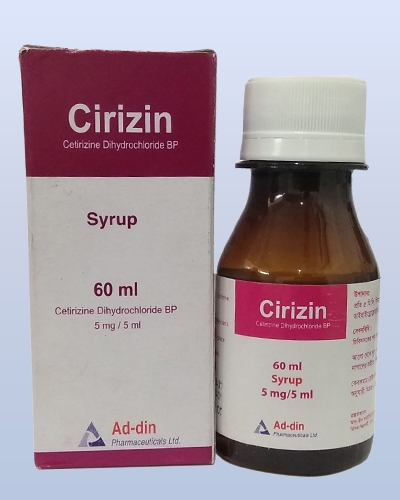ঔষধের বিস্তারিত বা বিকল্প ঔষধ জানতে ঔষধের নাম দিয়ে সার্চ দিন। যেমন- Napa বা Alatrol বা Amodis
Cirizin 10mg
TabletCetirizine Hydrochloride [Oral]
Ad-din Pharmaceuticals
Other Strength:
Alternative:
- Atrizin 10mg
- CETIZIN 10mg
- Alatrol 10mg
- Acitrin 10mg
- Noler 10mg
- Setir 10mg
- Rhinil 10mg
- Cetriz 10mg
- Cetriben 10mg

Cirizin
Description:
Cetirizine is a carboxylated metabolite of hydroxizine which acts as a potent H1-receptor antagonist. Chemically it is the dihydrochloride of 2-{4(4-chlorobenzyl)piperazin-1-y1} ethoxyacetic acid.
Composition:
Cirizin Tablet: Each film coated tablet contains Cetirizine Dihydrochloride BP 10 mg.
Cirizin Syrup: Each teaspoonful (5ml) syrup contains Cetirizine Dihydrochloride BP 5mg.
Pharmacology:
Cirizin is a potent H1 receptor antagonist without any significant anticholinergic and antiserotonic effects. At pharmacologically active dose levels, it has almost no drowsiness effect and doses not cause behavioural changes which may be explained by the absence of passage through the blood brain barrier.
Cirizin inhibits the histamine mediated early phase of the allergic reaction and also reduces the migration of inflammatory cells and the release of mediators associated with the late phase of the allergic reaction. Cirizin also provides a protective effect from bronchospasm induced by inhaled histamine in asthmatics.
Pharmacokinetics:
Cirizin is rapidly absorbed, reaching mean peak plasma concentration of 257 microgram per liter, within 1 hour of oral administration of 10 mg. Food does not reduce the extent of Cirizin absorption, although it may reduce the rate of absorption slighty.
Plasma protein binding is 93%, at concentrations ranging from 25 to 1000 microgram per litre. The terminal elimination half life ranges from 6.7 to 10.9h. The half life of cetirizine is slightly shorter in children than in adults, with values of 6.9-7.1h. The half life is increased markedly in renal dysfunction, with values of 19 and 21h in patient with mild and moderate renal impairment respectively (Creatinine clearance 1.9-3.6 and0.42-1.8 litre per h). The half life may be slightly prolonged in patients with hepatic dysfunction. Cirizin is eliminated mainly by renal excretion of the unchanged drug, although there is a small amount of metabolism in the liver.
Indications:
Seasonal Allergic Rhinitis:
Cirizin is indicated for the relief of symptoms associated with seasonal allergic rhinitis due to allergens such as ragweed, grass and tree pollens in adults & children 2 years and older. Symptoms treated effectively include sneezing, rhinorrhea, pruritus, ocular pruritus, tearing and redness of the eyes.
Perennial Allergic Rhinitis:
Cirizin is indicated for the relief of symptoms associated with seasonal allergic rhinitis due to allergens such as dust mites, animal dander, and molds in adults & children 2 years and older. Symptoms treated effectively include sneezing, rhinorrhea, post-nasal discharge, nasal pruritus, ocular pruritus and tearing.
Chronic urticaria:
Cirizin is indicated for the treatment of the uncomplicated skin manifestation of chronic idiopathic urticatia in adults & children 2 years and older. It significantly reduces the occurance, severity and duration of hives and significantly reduces pruritus. It is also used in allergen induced asthma.
Dosage, Uses and Administration:
Cirizin is indicated with or without food. The time of administration varies to suit individual patient needs.
Adults and Children 6 years and older:
Cirizin Tablet: 1 tablet daily.
Cirizin Syrup: 2 teaspoonful once daily or 1 teaspoonful twice daily.
In patients with decreased renal function (Creatinine clearence 11-31 ml/min), patients on hemodialysis (Creatinine clearence less than 7 ml/min) and in hepatically impaired patients, a dose of ½ tablet of 1 spoonful of syrup once daily is recommended.
Children 2-6 years:
Cirizin Syrup: 1 teaspoonful once daily or ½ teaspoonful twice daily.
Dosage in renal and hepatic impairment:
Dosing adjustment is necessary in patients with moderate or severe renal impairment, hepatic impairment and patients on dialysis.
Precautions and Warnings:
Caution should be exercised when driving a car or operating a heavy machinery. Concurrent use of Cirizin with alcohol or other CNS deperssants should be avoided because additional reduction in alertness and additional impairment of CNS performance may occur.
Drug-interactions:
No clinically significant drug interactions have been found with theophyline, azithromycin, pseudoephedrine, ketoconazole or erythromycin and with other drugs.
Side Effects:
Cirizin seems to cause an incidence of sedation similar to that observed with placebo and with other non-sedating antihistamines such as astemizole and terfenadine and causes a lower incidence of sedation than that with ketotifen, clemastine, pheniramine, chlorpheniramine of mequitazine, Cirizin dose not cause anticholinergic effects.
Contra-indications:
Cirizin is contra-indicated in patients who have shown hypersensitivity or idiosyncrasy to Cetirizine or to its parent compound, hydroxyzine.
Use in pregnancy and lactation:
There are no adequate and well-controlled studies in pregnant women using cetirizine. Therefore cetirizine should be used in pregnancy only if clearly needed. cetirizine has been reported to be excreted in human breast milk and thus, use of cetirizine in lactating mother is not recommended.
Storage Requirement:
Should be stored in a dry place below 300c
How supplied:
Cirizin Tablet: box containing 10X10’s tablets in blister pack.
Cirizin Syrup: Amber glass bottle containing 60ml syrup.
Manufactured by:
Ad-Din Pharmaceuticals Ltd.
এই পাতাটি ৩২২ বার দেখা হয়েছে
রাজডক কী?
ফ্রী সদস্য হোন Click Here
ডাক্তার হিসাবে যোগদান করতে Click Here
নার্স / টেকনোলজিস্ট হিসাবে যোগদান করতে Click Here
ফ্রী সদস্য হোন Click Here
ডাক্তার হিসাবে যোগদান করতে Click Here
নার্স / টেকনোলজিস্ট হিসাবে যোগদান করতে Click Here

